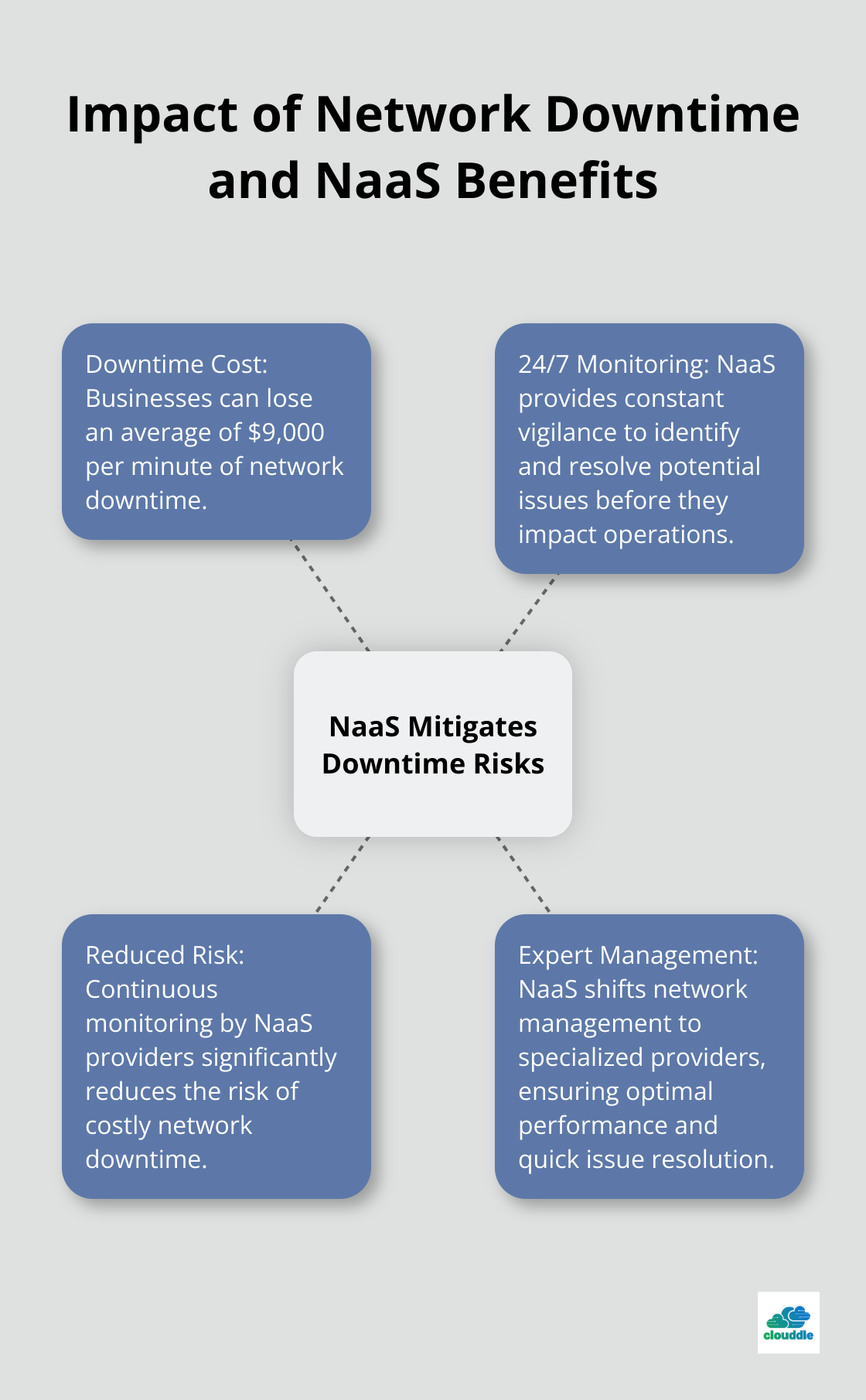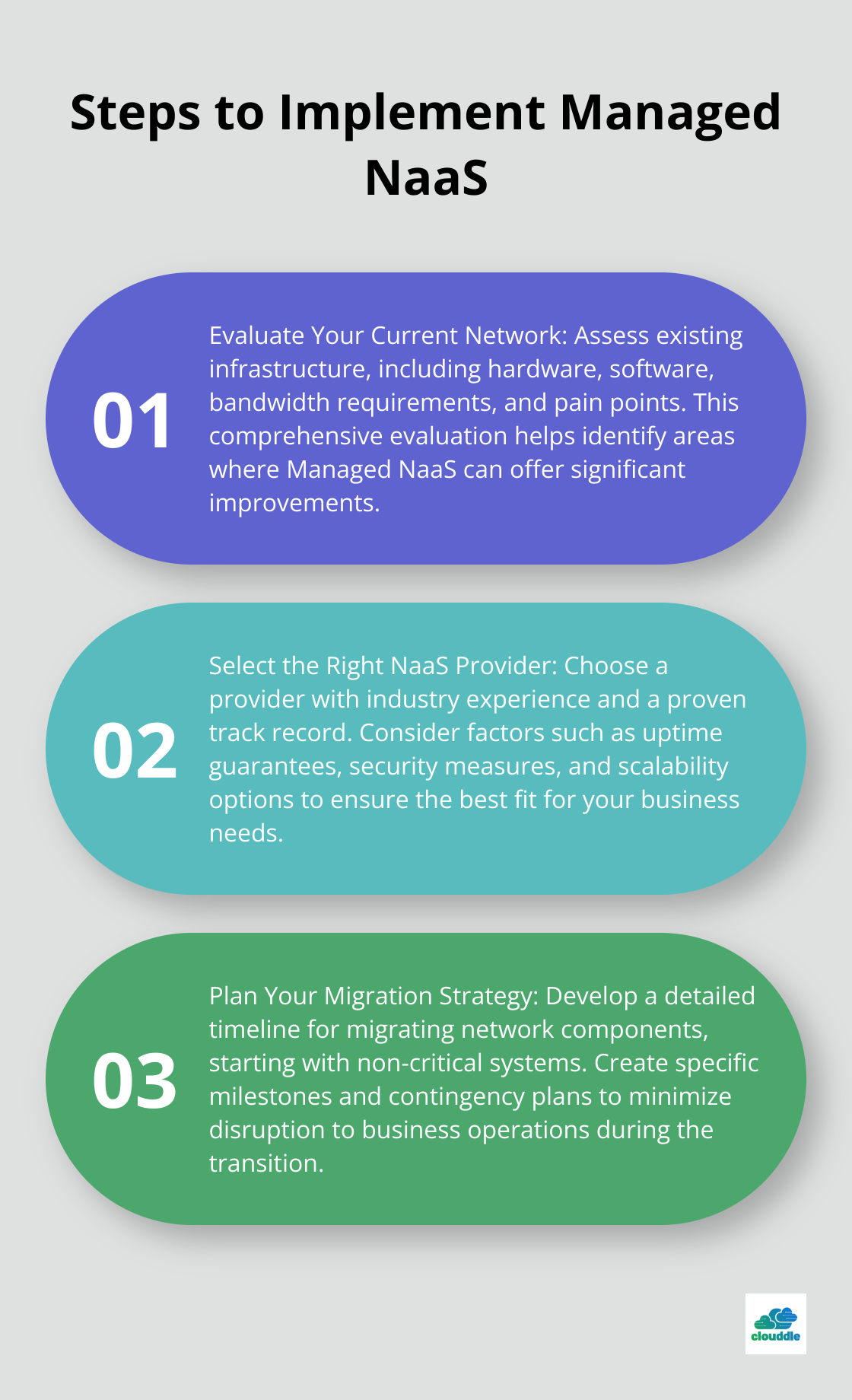Managed Network as a Service (NaaS) is revolutionizing how businesses handle their network infrastructure. This innovative approach offers a more flexible, scalable, and cost-effective alternative to traditional network management.
At Clouddle, we’ve seen firsthand how Managed NaaS can transform operations for companies of all sizes. In this post, we’ll explore what Managed NaaS is, its key features, and how you can implement it in your business to drive growth and efficiency.
What is Managed Network as a Service?
Redefining Network Management
Managed Network as a Service (NaaS) transforms how businesses handle their IT infrastructure. This cloud-based service model delivers networking applications, functions and services that a managed service provider (MSP) remotely operates, monitors and maintains.
Traditional vs. NaaS Approach
Traditional network management involves significant upfront costs, complex installations, and ongoing maintenance challenges. Businesses must purchase, configure, and maintain their own network equipment-a costly and time-consuming process, especially for smaller organizations without dedicated IT staff.
NaaS shifts network management responsibility to a third-party provider. The provider owns and maintains the network infrastructure, while businesses access these services on a subscription basis. This shift from a capital expenditure (CapEx) model to an operational expenditure (OpEx) model sets NaaS apart.
Key Components of NaaS
NaaS encompasses a wide range of network functions:
- Wide Area Network (WAN) connectivity
- Local Area Network (LAN) management
- Network security services
- Virtual Private Networks (VPNs)
- Software-defined networking (SDN)
These components are delivered as a service, allowing businesses to adjust their network capabilities based on their needs.
Concrete Benefits for Businesses
NaaS adoption offers several tangible advantages:
- Cost Efficiency: The global NaaS market is projected to grow from USD 13.2 billion in 2022 to USD 46.6 billion by 2027, with a CAGR of 28.7%, indicating significant cost benefits for businesses.
- Scalability: NaaS allows quick adjustment of network resources. A Flexera survey found that 59% of enterprises consider scalability a top benefit of cloud services like NaaS.
- Enhanced Security: NaaS providers often dedicate more resources to security than individual businesses. The 2021 Cybersecurity Ventures report predicts cybercrime will cost the world $10.5 trillion annually by 2025, highlighting the importance of robust security measures.
- Simplified Management: IT teams can focus on strategic initiatives rather than day-to-day network management. A Gartner study suggests NaaS can reduce network management time by up to 50%.
- Access to Expertise: NaaS providers employ specialists who stay current with the latest networking technologies and best practices.

These benefits translate into real-world advantages for businesses across various industries (hospitality, multi-family dwelling, and senior living sectors). NaaS solutions help streamline operations and boost bottom lines, paving the way for the next evolution in network management: key features that make NaaS a game-changer for modern businesses.
What Makes Managed NaaS Stand Out?
Round-the-Clock Vigilance
Managed Network as a Service (NaaS) transforms network infrastructure management for businesses. One of its standout features is 24/7 network monitoring and management. This constant vigilance identifies and resolves potential issues before they impact business operations. According to a Ponemon Institute study, just one minute of downtime can cost a business an average of $9,000. NaaS providers significantly reduce this risk through continuous monitoring, potentially saving companies substantial amounts in losses.

Adapting to Business Rhythms
Scalability and flexibility form the core of Managed NaaS. As businesses grow or experience seasonal fluctuations, their networks must keep pace. A Flexera report indicates that 59% of enterprises consider scalability a top benefit of cloud services like NaaS. This adaptability allows businesses to adjust their network resources in real-time, ensuring optimal performance without overprovisioning or underutilizing resources.
Fortifying Digital Defenses
In an era of evolving cybersecurity threats, Managed NaaS provides robust security measures and threat protection. Cybersecurity Ventures expects global cybercrime costs to grow by 15 percent per year over the next five years, reaching $10.5 trillion USD annually by 2025. NaaS providers leverage their expertise and resources to implement advanced security protocols (including firewalls, intrusion detection systems, and encryption). This comprehensive approach to security helps businesses stay ahead of potential threats and comply with industry regulations.
Data-Driven Performance Optimization
Performance optimization and analytics play a critical role in Managed NaaS. NaaS providers continuously collect and analyze network data to identify bottlenecks, optimize traffic flow, and improve overall network performance. A Gartner study suggests that NaaS can reduce network management time by up to 50%, allowing IT teams to focus on strategic initiatives rather than day-to-day troubleshooting.
Seamless Integration and Support
Managed NaaS offers seamless integration with existing infrastructure and provides ongoing support. This feature ensures a smooth transition to the new network model and continuous assistance for any issues that may arise. The support aspect of NaaS (which often includes 24/7 customer service) proves particularly valuable for businesses without extensive in-house IT resources.
These features collectively make Managed NaaS an attractive option for businesses looking to streamline their network operations, enhance security, and improve overall efficiency. The next section will explore how businesses can implement Managed NaaS to leverage these benefits and drive growth.
How to Implement Managed NaaS
Implementing Managed Network as a Service (NaaS) is a strategic process that requires careful planning and execution. Here are the key steps to successfully integrate NaaS into your business operations:

Evaluate Your Current Network
Before you adopt NaaS, assess your existing network infrastructure. This evaluation should encompass your current hardware, software, bandwidth requirements, and pain points. A comprehensive assessment will help you identify areas where Managed NaaS can offer the most significant improvements.
Select the Right NaaS Provider
Choosing a NaaS provider is a critical decision that will impact your network performance for years to come. Look for providers with experience in your industry and a proven track record of reliability.
When you evaluate providers, inquire about their uptime guarantees, security measures, and scalability options. Clouddle offers flexible contracts and bundled solutions tailored to specific industries (like hospitality and senior living), ensuring that businesses receive exactly what they need without unnecessary extras.
Plan Your Migration Strategy
A well-planned migration strategy is essential to minimize disruption to your business operations. Start by identifying which network components you’ll migrate first. Many businesses begin with non-critical systems to test the waters before moving core operations.
Create a detailed timeline for the migration, including specific milestones and contingency plans.
Prepare Your Team
The success of your NaaS implementation largely depends on how well your team adapts to the new system. Invest in comprehensive training programs to ensure your staff can effectively use and manage the new network infrastructure.
Consider designating NaaS champions within your organization who can serve as go-to resources for their colleagues. These individuals should receive advanced training and act as liaisons with your NaaS provider.
Monitor and Optimize
Once your NaaS solution is in place, continuous monitoring and optimization are key to maximizing its benefits. Review performance metrics regularly and work with your provider to fine-tune the network based on your evolving needs.
Final Thoughts
Managed Network as a Service (NaaS) revolutionizes network operations for businesses across industries. This innovative solution streamlines processes, enhances security, and boosts overall efficiency. Companies that adopt NaaS can focus on their core competencies while expert providers handle their network infrastructure.
NaaS offers clear advantages: lower capital costs, improved scalability, and access to cutting-edge technology. These benefits translate into tangible improvements, from reduced downtime to increased market responsiveness. The future of NaaS promises continued growth and innovation, with potential advancements in AI-driven optimization and integrated edge computing solutions.
Clouddle combines networking, entertainment, and security services into a seamless package for various sectors. Our approach allows businesses to leverage advanced technology without initial investments or management complexities. NaaS positions organizations at the forefront of technological innovation, ready to meet the challenges of an increasingly connected world.


